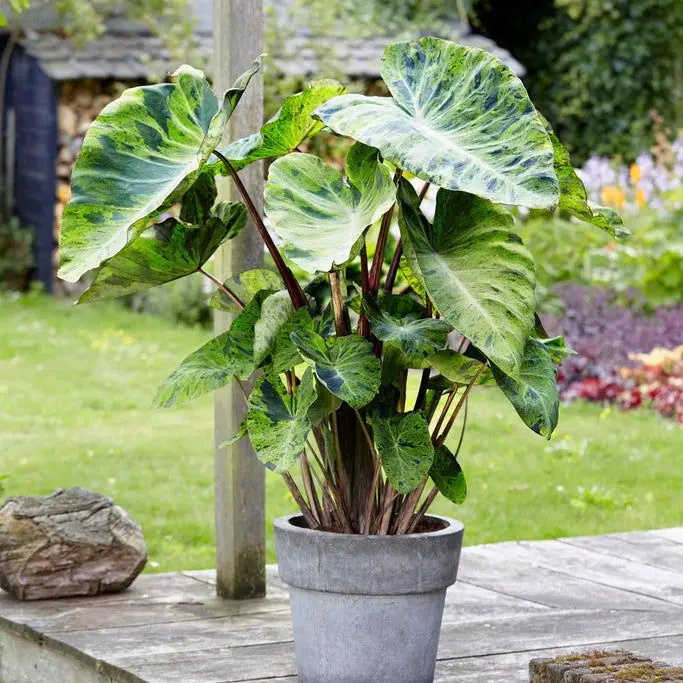Anyone after a dramatic and impressive plant for their garden needs to look no further than Colocasia and Alocasia. Elephant Ears, known by their more common name, are popular as garden and house plants due to their impressive foliage.
You can easily spot Elephant Ears by their large leaves, measuring up to 2 feet wide. They might not bloom, but their vivid, lush leaves of varying shapes and textures create a dramatic landscape.
Stunning leaves also range from lime green to dark emerald green, giving your garden a new lease of life. Such variety means that Elephant Ear bulbs look great matched with annuals and summer bulbs.
Unfortunately, many gardeners have problems knowing when to plant bulbs.
However, we’ve got you covered, so carry on reading our best gardening tips for this type of plant.
When to plant Elephant Ear bulbs?
Knowing the best time to plant Elephant Ear bulbs is easier than you may think. To give these popular tropical plants their best chance of thriving, plant them in spring when you’re happy the risk of frost has passed.
The soil should be warm for the tubers to grow, so avoid planting until the soil temperature has reached 65ºF. Planting in northern climates will usually be in June and are known as annuals.
Can I grow Elephant Ear bulbs now?
Yes, there are circumstances when you can now plant your Elephant Ear bulbs. For example, if you live in a warmer climate with no risk of frost, you can plant your Elephant Ears all year round.
If you’re eager to get your Elephant Ears started early, plant them indoors as houseplants four to six weeks before you’re planning on getting them outdoors.
Grow the tubers in pots and put them in a sunny, warm window.
How long does it take for Elephant Ear bulbs to grow?
So, you might know when to plant Elephant Ear bulbs, but what do you do when these huge plants grow? Once you’ve planted them, you might need a little patience as Elephant Ear tubers can be a little on the shy side.

You might not find your Elephant Ears sprouting for a good month, depending on when and where you’ve planted them. But when you plant your Elephant Ears in spring, you’ll find yourself with impressive and decorative plants in just a few months.
For the best chances of this, follow the below care tips for your Elephant Ear bulbs;
- Give your Elephant Ear bulbs plenty of room to grow, as they sprout huge foliage when grown.
- To get the most out of your planted tubers, always plant your Elephant Ears in well-drained and rich mulch.
- Improve the soil before planting by adding nutrients and improving the potting soil’s water-holding capacity. Add compost or topsoil to your soil before planting.
- Ensure your Elephant Ear bulbs have regular moisture throughout the summer, or they may not reach their full size.
- Apply liquid fertilizer once every two to three weeks to help your Elephant Ear bulbs reach their full size.
Do Elephant Ear bulbs come back every year?
You don’t just need to know when to plant elephant ear bulbs; you also need to know when to dig them up and protect them from frost.
If you live in a warmer location, such as the tropical, lower, or coastal south, your Elephant Ear bulbs will bloom every summer as perennials. These locations work well because Elephant Ears like relatively dry soil in winter.
However, for gardens farther north, in the colder regions, you’ll need to store them in a cool, dry place over the winter.
Then, all you need to do is:
- Dig up your Alocasia or Colocasia bulbs from the ground before the first frost or ideally before fall temperatures drop past 40°F.
- Cut off the considerable foliage.
- Cut back the stems once the root ball is dry.
- Give the tuber more time to dry. Wrap each tuber in a piece of paper and store it in a dark, warm, and dry place over the winter. Sheds, garages, and greenhouses usually work.
- Move the entire pot into a warm area of your home or a greenhouse if you’ve planted your Elephant Ear bulb in a pot.
- Keep your Elephant Ear plant evergreen over the winter by maintaining a temperature above 21C. In addition, keep the soil regularly moist but not wet, and plant in bright, indirect sunlight or partial shade. Avoid full sun exposure.
Remember; even if the foliage does die back due to lower temperatures in the winter, your plant will still grow new leaves yearly as long as they are kept frost-free.
But if this seems like too much effort or you can’t store your Elephant Ears, you can treat them as annuals and discard them at the end of their growing season.
Do you plant Elephant Ears in the sun or shade?
Again, you don’t just need to know the best time to plant elephant ear bulbs; you also need to know what lighting conditions they prefer.
Remember that Elephant Ears’ best-growing conditions include sunny but partially shaded locations from the intense sun. But they do like plenty of heat and humidity. So, plant your Elephant Ears in bright spots or shaded areas.
If you’ve planted your Elephant Ears planted in a hot and sunny area, make sure they get some shade during the middle of the day.
What month do Elephant Ears bloom?
Elephant Ear plants don’t bloom in the traditional sense. However, their leaves bloom into magnificent, lush, large, and textured beasts. Once they’re ready, you’ll find your Elephant Ears come with a vast arrange of shapes and colors.
If you’ve planted your Elephant Ears in early spring, they could bloom anywhere from late spring to early fall, depending on the conditions.
But, when you have planted your tubers indoors four to six weeks before the last frost has disappeared, you’ll be pleased with earlier blooms.
